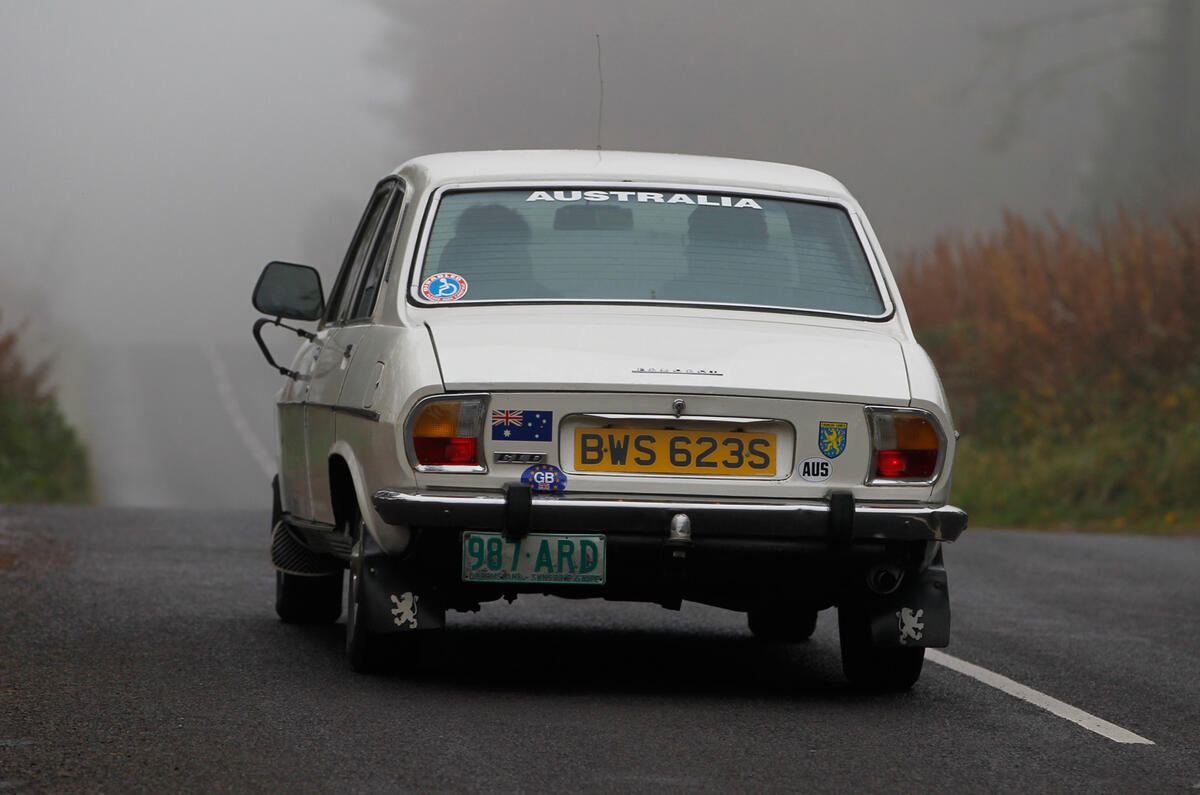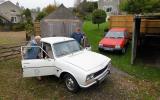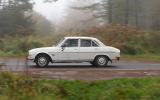Were Keith Herbert’s Peugeot 504 an ordinary car, it would have been scrapped 15 years and half a million miles ago.
It certainly wouldn’t be living in a warm Wiltshire garage as it does today, still in daily use but fêted for having covered more than a million kilometres (625,000 miles) in a globetrotting life of drama and adventure.
As the most recent of the car’s five owners, Peugeot lover Keith Herbert, a retired haulage boss who lives near Bath, has ‘only’ owned the car for the past 15 years, storing it alongside four other Peugeots. During that time, he has added a ‘modest’ 100,000km but, most important, he has had the distinction of turning up the magic million on its kilometre-reading odometer.
The famous 504 started life in a Renault-owned assembly plant in Melbourne, Australia, under a curious colonial deal struck between the French automotive rivals that led to 504s being built alongside Renault’s own R12s and R16s. This 504, a 2.3-litre GLD diesel with a four-speed gearbox, was delivered to its first owner 1500 miles away in Brisbane, on the Queensland coast.
From the beginning, it was driven hard. Three give-no-quarter owners put 300,000 miles on the car in its first nine years, which would have been enough to bring most cars to their knees. Not the 504. “At that stage,” says Herbert, “the car was acquired by the bloke who eventually sold it to me, an Australian farmer who had emigrated from Ireland called Graham Smith. He overhauled the engine – and then the hard part of its life began.”
Smith loved travelling, and the car he most loved driving was this china-white, Melbourne-made 504, its engine now rejuvenated.
Between 1988 and 1996 the car was driven almost non-stop in Queensland’s ‘unimproved’ outback, where roads were usually rutted, corrugated and covered in loose stones that put the windscreen at risk. A particular problem was ‘bulldust’, a notorious airborne form of red dirt that can bypass even the best door seals.
For much of this time the 504 was used by Smith’s daughter, whose job as a relief teacher at various far-flung native Australian settlements took her on 1000-mile journeys in temperatures beyond 40 degrees.
These were tough and risky conditions for anyone driving alone, Smith recalls, but the combination of the Flying Doctor and the renowned Australian ‘bush telegraph’ kept her safe. And the car never failed to proceed. When Smith’s daughter stopped using the 504, it was taken over by her husband, a noted leadfoot, who pushed it to the limit.
Throw in a few of Smith’s own 3000-mile round trips and it’s no wonder that 140,000 miles further on – and with the odometer reading an amazing 880,000km (550,000 miles) – the 504 needed more refurbishment: new rings and bearings, a new timing chain, a secondhand cylinder head, new gearbox seals, a differential rebuild, new suspension bushes and a brake overhaul.
Why did these people persist with this 504, which was now very old in most people’s terms? The answer is simple: early in its life, the 504 acquired a legendary reputation for ruggedness and reliability; this one was still too good to throw away.
As Herbert notes, in their heyday 504s sold in reasonable numbers in the UK, but they are rare here today because in older age, after a life of comparatively light duty, most were bought up and shipped to Africa, to live again in tougher conditions.
“Sometimes exporters would cut off the roofs at the base of the pillars,” he says, “because you could get more bodies into a container that way. They’d weld the roofs back on in Africa because there were no laws against that kind of thing.”
In 1997 Smith decided to return to Ireland. What better way to get there than to drive the Peugeot, via Asia and Europe? Mechanical work completed, he loaded the 504 into a container bound for Bombay, met it there and drove on a circuitous route to Europe via northern Pakistan, where at one stage he encountered a crowd of Kalashnikov-wielding teenagers who advised him to buy a weapon of his own as a way of making the onward journey easier.
Crossing Iran took a week (1500 miles of bad roads and bureaucracy) although one advantage was that fuel cost just 50 pence per tank. Gradually, the route became easier, and fuel more expensive, as he drove through Turkey, Greece, Italy, France and crossed the Channel at last into the UK.
Here Herbert, nowadays the million-kilo 504’s owner, enters the story. At the time he was secretary of the UK’s Peugeot Club. Globetrotting Smith, having reached his destination, reckoned that Herbert and his club members might help find a new home for the much-travelled 504. He was right about that: the secretary himself snapped it up and the 504 moved into elegant semi-retirement in Wiltshire.
Herbert had acquired his love of the marque several decades earlier during a chance encounter with a 504 traded by a friendly local dealer. “I’d been running lots of British stuff,” he says, “and happened to drive a ’71 petrol 1.8-litre, just to help the guy make a delivery.
I was so impressed with its steering, ride, brakes and handling that I ended up buying it. I ran it for a couple of years, then bought a new 504 estate and I’ve had Peugeots ever since.” Today, Herbert owns the 504, as well as a 604, a 304 coupé, a 305 estate and a 205, whose immaculate body belies the 202,000 miles on its odometer.
The day we called at Herbert’s place, the weather was dank and drizzly, the kind of day on which owners of rare cars prefer to keep them inside. But the world’s toughest 504 was raring to go. We started with a walk around, noting the dent near the fuel filler (“that was done by a donkey in Turkey”), the Queensland tax disc still inside the windscreen, the mountings for a genuine Aussie ‘roo bar’ (now hanging in one of Herbert’s sheds) and the abundant signs of Waxoyl, which has kept the dreaded tinworn mostly at bay.
There were modifications. The dampers were beefier Konis, there was a homemade anti-glare cover on the top of the dashboard – remarkably intact, given the fragility of 1970s French plastics – and a mod to the ignition switch to make it fixable in a back-roads breakdown.
The radiator had a second header tank and Smith had fitted a powered steering rack from a 505 (which bolts straight on and improves on the 504’s under-geared unassisted steering). There was a new battery (“It cost me 50 quid, Steve – this is getting expensive”) but the vast boot still contained the same small box of spares that the car had carried across the world. The general message was that over the past 60,000 miles, breakdowns had been non-existent and maintenance easy.
We drove on some of Herbert’s favourite roads. I’d had various brushes with the Peugeot 504, years ago in Australia, when it was a current model and we’d even had one in the family. The appeal of its low-rate, strolling ride and unhurried, flexible power delivery – much too torquey for its amazingly low 70bhp power output – came flooding powerfully back.
I loved the sweetness of this 504’s gearchanges (how many million ratio swaps had smoothed this velvety mechanism?) and also its thin screen pillars, which made pulling across crowded junctions seem so much easier than usual. Once rolling, the car was well able to stay with modern traffic and, unlike many cars of the period, it seemed to have all the grip and stability it needed, rolling along on 70-series Michelins.
Herbert was pleased at my reaction, but not surprised. He drives the 504 often and knows that it’s good. He’s never precious about its antiquity, either, although it must be considerable. “It’s not the car’s value that’s important,” he says. “It’s how good it still feels, given where it has been and what it has done.”













































Join the debate
Add your comment
If you like to ride more than
If you like to ride more than 500 000 km.
There are other cars :
- Volvo P1800.
- Renault 21 (Turbo)Diesel.
The 504. An enviable
The 504.
An enviable reputation of reliability.
For a long time used in Africa.
It's the same for the 404.
President Ahmedinejad (Nobel
President Ahmedinejad (Nobel Peace prize), auctioned off his 504, and the final bid was a reported $2.5 million. wikipedia. Pininfarina styling, and assembled in over 10 countries, upto 2005.
kcrally wrote:
Why mention Nobel Peace Prize in this context?.